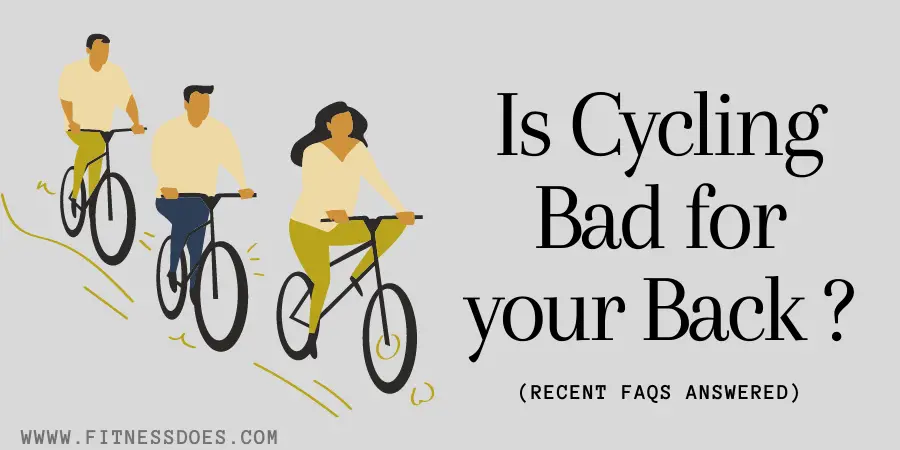While working to strengthen your back midsection, cycling can play an important role. Your abdominal muscles serve as the bedrock of your riding performance.
Overcompensation by the lower back muscles for a weaker core can cause muscle overload, the strain on the spine’s muscles and ligaments, and stiffness and discomfort. Is cycling bad for your back, then?
Lower back pain sufferers can find relief from cycling, as it is a minimal sport. If you’re recovering from an injury, cycling is a great activity that won’t put too much pressure on the back if you maintain the correct posture and use the ideal bike size and setting.
So why does cycling lead to pain in the lower limb? Let’s dig out the answer!
Is Cycling Bad for Your Back?

According to trial-controlled research, it is reasonable to assume that a patient with low back pain will see similar benefits from targeted trunk exercises or stationary cycling.
Why cycling causes back pain?
- Poor posture is a sure way to give yourself a backache. Very poor posture includes slouching excessively with a rounded upper back and a jutted chin. Bicycling does provide much in the form of endurance for the back muscles.
- Due to the lumbar spine bending or pulling up, poor back posture when riding a bicycle can cause pressure on the lower back.
- Arched back while riding a bike, notably with aero bars, can cause neck and upper back pain.
- Back discomfort is a common complaint among hikers because of the increased jarring and compression on rough terrain.
How to reduce the pain then?
- Keep the arm curved a little when riding so that your upper body may take the brunt of the shock instead of the spine. If your seat is adjusted correctly, the knees will bow slightly towards the conclusion of the stroke rather than fully extending.
- When finishing a stroke, the knees should be bent at a right angle (at least 90 degrees). Your lower back will appreciate this change.
- If you’re going to be cycling for long ranges, it’s a good idea sometimes to switch up the angle and posture of your torso so that the muscle doesn’t get stiff and tired from staying in the same position the whole time.
- The spine can be jolted and compressed when cycling over tricky terrain or steep hills as an added risk. Bikes that don’t fit properly and people who lack strength in their abdominal and hip muscles also have a role. So go for the conventional type of bicycle discussed below.
Help! My back hurts after I go cycling—what can I do?
Take a Rest
Medical professionals are likely to recommend bed rest as the first line of treatment for various reasons. Getting some sleep usually helps, at least temporarily. In any case, you might always… Try walking or using an elliptical trainer to prevent the adverse health effects of inactivity.
Check the position of the saddle and pedals.
If the saddle is too elevated, your hips may unconsciously sway from side to side. When the pedals are at their minimum level, your knee should be bent between 25 and 35 degrees. Visiting a bicycle store where experts can evaluate your gear and suggest ways to improve or replace it is time well spent.
Train under an expert
You should have a more experienced biker observe your form. As a result, an expert may see issues that might go unnoticed by a newbie. Similarly, getting advice from a professional at a bike store about your gear, posture, and skill will help you ride faster, further, and with less discomfort.
What type of bike is best for cycling?
You should ride a bike that is properly fitted to your height, weight, and other measures to prevent or reduce lower back discomfort.
It’s also essential to get a bike that’s suitable for your needs. Don’t get a fast road bike if you plan on riding on dirt trails.
If you want to find a bike that fits you well when buying, it’s best to go to a cycling shop instead of a random mall. If the bike is too large for you, you may strain your back, reaching forward for the bars.
Recumbent Bicycles
The rider’s back can get some much-needed relief with the help of specialized bikes. The recumbent bike is by far the most common kind.
FAQ’s
1- Can you build strong back muscles by riding a bike?
The physical activity focuses on the core. You’re using your back and abdominal muscles when you ride a bike. Riding a bike properly demands a solid core to maintain you balanced and upright. Fitness goals for cyclists include building core strength and back muscular endurance to reduce back pain, boost balance, and lessen discomfort.
2- Can cycling worsen sciatica pain?
If you ride a complex cycle, you might put extra strain on your lower back and sciatic nerve. Riding slumped and forward posture might aggravate sciatica if your saddle and handlebars aren’t set up correctly.
3- If you have a poor back, which bike would you recommend?
Specifically, what kind of bike would be ideal for people with back problems? A comfort cruiser or hybrid will be better if your bike is flimsy. For example, the low, cushioned chairs ordinary aboard cruisers mean you won’t need to stretch the knee thoroughly.
Concluding!
Now you get that. Is cycling bad for your back? Generally, it’s not, but if you are not doing this correctly, including posture, speed, height, etc., it will lead to back issues. I believe this has answered your question. So consult with an experienced cyclist and get back on track.
Related Articles :
